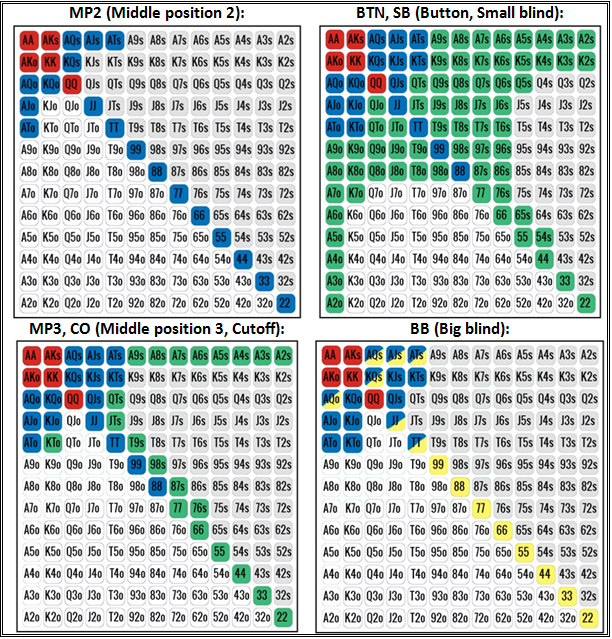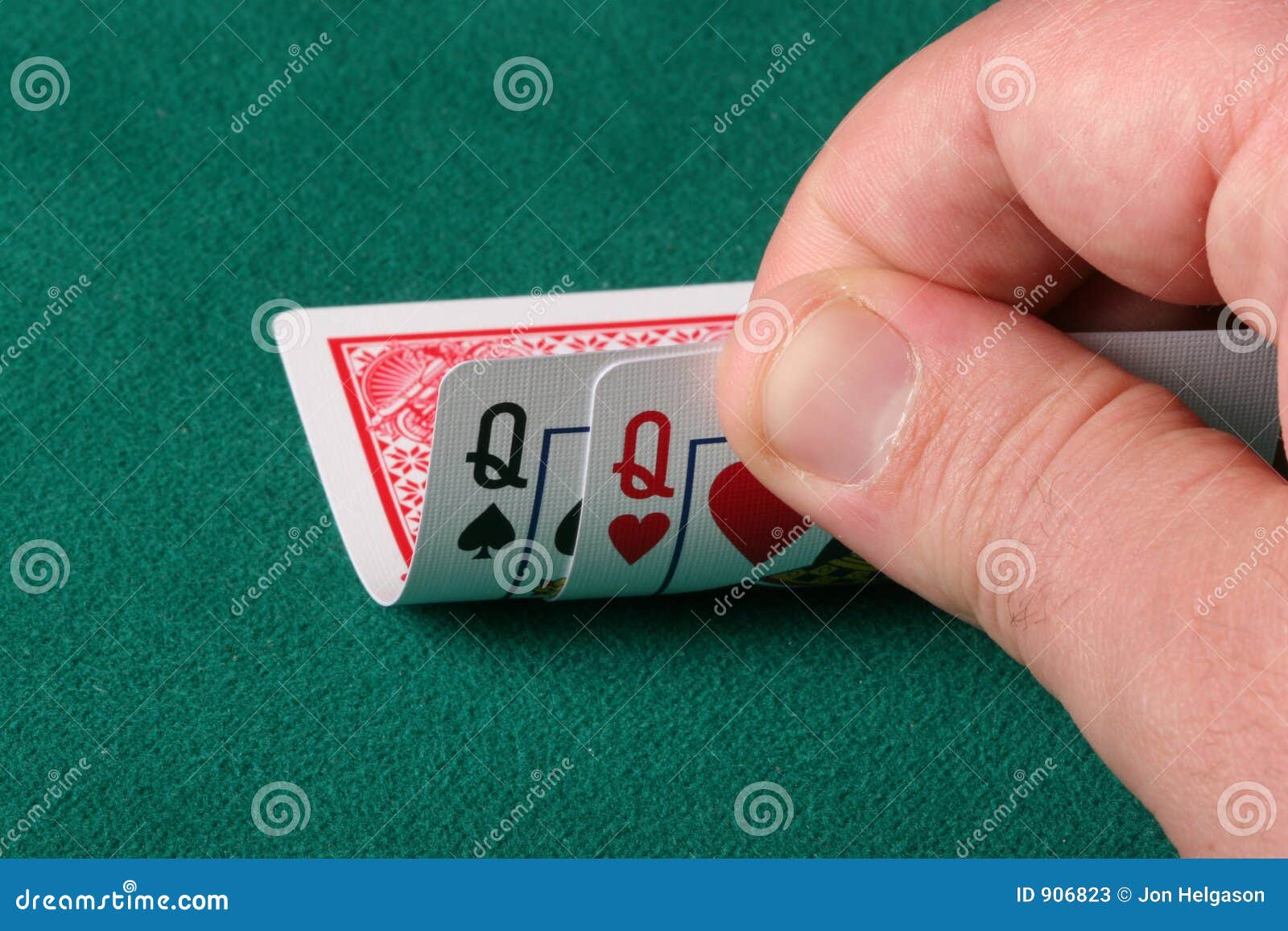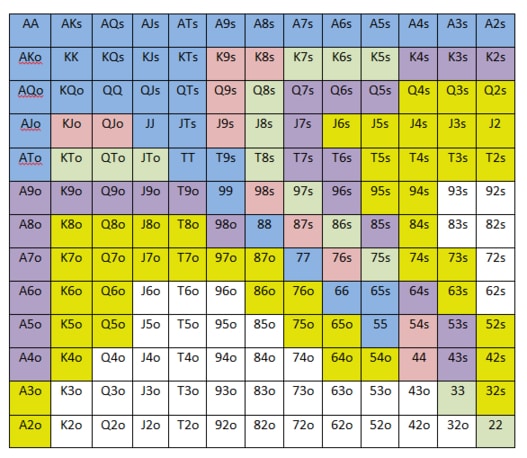6 Max Holdem Starting Hands
- Best Starting Hands Holdem
- 6 Max Holdem Starting Hands Game
- Holdem Starting Hands Chart
- Texas Holdem Starting Hands Chart
- Limit Hold'em 6 Max Starting Hands
By Rob Smith
The workbook is 100 pages in length and is targeted for 100NL cash game hold’em players and below. 6-max Poker Starting Hand Charts admin 2019-07-16T22:37:25+00:00 Leak Buster 2 6-Max Poker Starting Hand Charts. 6-Max Loose Aggressive Start Hand Charts (Suggested for advanced players. All Texas Hold’em starting hands can be separated into two categories: “suited” and “offsuit”. Suited hands contain two cards of the same suit, like J♣9♣, A ♥ K ♥, K♠Q♠ and 9 ♦ 3 ♦. All other starting hands are in the offsuit category, like A♠8 ♦, 7♣5 ♥ and K ♥ 9 ♦.
Introduction
In today’s online cash games, most poker sites offer three options for table size: Heads-up (2 seats), full ring (9 or 10 seats), and 6-max (6 seats). Over the last couple of years, the 6-max tables have become the most popular by a significant margin. There are a number of reasons for this:
- More hands per hour. As there are fewer players to make a preflop decision and usually less players to a flop, the game runs a lot quicker than when at a full table. While this may not improve winrate in terms of BB/100, it can make a big difference to your BB/hour winrate, purely because you’re playing more hands.
- More action. Similar to above, but not only are you playing more hands per hour, there’s more flexibility to play a larger percentage of preflop holdings. The beauty of 6-max is that there is no “correct” style. You can profit playing very tight and solid, or extremely loose and aggressive playing every other hand (If you are extremely skilled post flop!)
- Nowhere for weak players to hide. In a full ring game, there may be one or two very weak players at the table that you would like to play as many pots as possible with. Even if they are directly on your right, most of the time you can’t raise to isolate with weaker holdings due to there being too many players left to act with position on you. This isn’t usually the case in 6-max, and allows for many more profitable situations for strong players.
- Rapid improvement in skill level. You will generally be playing more post flop poker and contesting more pots than you would in full ring. This should allow you to gain experience at a much faster rate, and therefore improve quicker.

I used to play full ring almost exclusively, but one day I thought I’d try out 6-max for the reasons above. After a few fundamental adjustments to my play (and 10 buyins down later), I found myself winning in a more profitable and quite frankly, more entertaining game. If you are a full ring player who has always wondered about 6-max but you’re afraid of either “getting blinded away” or “playing too many marginal spots”, then this article is for you.
Variance
If there’s one reason I hear more than any other for not playing 6-max holdem, it’s that the variance is too high. Some people simply don’t want to endure the downswings associated with a higher variance game of poker. While it is true that your standard deviation per 100 hands will be higher in 6-max than full ring, this should not be a factor in whether you play the game or not. We are supposed to be playing for the long term! If you are adequately bankrolled, then you will do better playing in the game which earns you the most money per hour, regardless of the variance. Remember, variance doesn’t alter your mean winrate, just your spread of results around that winrate. This means above it too! Most players forget this. When you have a monster session and finish up 6 – 8 buyins, do you put it all down to playing well? Or are you aware enough to be able to say “In that session I ran way above my average winrate due to variance.”

Be Observant
With a maximum of only five opponents, you have the opportunity to pick up on, and exploit you opponents’ tendencies much more rapidly in a 6-max game. This is the core skill you need in order to make the best decisions and extract the most profit. You need to know if the player on your left will 3-bet you lightly preflop, or if the guy opposite you pushes top pair too hard. Who will fire 2 or 3 barrel bluffs, and who plays strictly fit or fold on the flop? All of your profit comes from exploiting your opponents’ mistakes, and you can only do that if you know what those mistakes are.
NEVER Open Limp Preflop
This is the only hard and fast rule I am going to give you in this article. While it’s possible to employ a profitable strategy involving preflop limping, it’s extremely difficult to balance and relies on expert post flop play. For the vast majority of players, it’s simply better to raise any pot you want to enter first. 3 or 4 times the big blind will do it. If you limp, not only will you be isolated out of position a lot, it will be more difficult to build big pots with your monsters. It also makes hand reading a nightmare, especially if you let the blinds in for free.
Throw out that Starting Hand Chart!
Choosing whether to enter the pot in 6-max is very much a function of the observations you have been making. For this reason, starting hand charts will only get you so far. For a start you DON’T have to play more hands than full ring. This is a very common misconception. You generally want to be playing, and raising with a lot of hands from the Button and the CO (Cutoff), but playing very tightly from UTG (Under the Gun) and MP (Middle Position). What these hands are depends on your opponents, and their positions at the table.
So let’s come up with a couple of examples to illustrate this. Here’s a 6-max table with a typical range of opponents. Assume 100BB effective stacks:
SB Tight Passive & predictable postflop
BB Loose Passive & Calling Station postflop
UTG Loose Aggressive
MP You
CO Tight Aggressive, passive on turn and river
BTN Semi-loose & Aggressive preflop, tricky/deceptive
In the above example, if UTG folds, what range should you open with?
You have to stay fairy tight. You are in early position, and there’s a loose aggressive player on the button. I would open:
AA-22, AJs+, ATo+, KJs+, KQo, QJs, JTs
A fairly tight range of mainly premium hands.
Now keep the same players in the blinds, but put yourself on the button. What hands will you open with now if everyone folds to you? A typical range:
AA-22, A2s+, A2o+, K2s+, K7o+, Q6s+, Q8o+, J7s+, J9o+, T8o, 97o, any suited connector, any suited one-gapper, any unsuited connector.
Obviously this is a huge range of hands. In fact, a lot of players will open any two cards here! The reason is that the raise is often profitable in itself against two passive players in the blinds. Especially when combined with a c-bet on the flop (see the next section.) Hopefully you can see that how many hands you decide to play is down to your specific table, your style, and your postflop skill. Just remember that if you’re in any doubt, it’s best to play tight and solid. This still gets the money, even at 6-max.
C-Betting
C-betting is the bread and butter of 6-max holdem. If you raised preflop and get one or two callers, you will be betting most flops whether you hit or miss. These bets should be somewhere between ½ and full pot size. How to choose what size in this range depends on a number of things:
- Flop texture
- Number of opponents
- Opponents tendencies
- Balance
- Own hand strength
C-betting is a topic that requires an article in itself to cover properly, so I won’t attempt to reproduce that here. Just be aware that part of the reason you are raising so much preflop is to take the pot down often with a c-bet on the flop.
Wield Position (No, even more than that)
Most players know that position is to your advantage in NL Holdem, but they simply don’t use it as relentlessly as they should. When you have position, especially on the button, you should be raising a lot of pots. On a tight/weak table, it’s difficult to go too far with this. Raise any limped or unopened pot on the button with all but the trashiest of hands.
Position can be used to exploit different opponent types in various ways. If you have a weak TAG on your left who calls from the blinds too much but gives up too easily post flop, you can raise all sorts of hands from the button and cutoff. You can then apply pressure and 2 or 3 barrel him depending on the situation, making him lay down the vast majority of his range. If you are playing with a loose passive fish on your right, you can also isolate with a wide range. Unless he picks up a big hand, he’ll mostly be check/calling to the river, allowing you to choose where to value bet, and where to check behind. These are the sorts of situation where position gives you a huge advantage, so make sure most of your hands are played in position.
Manipulating Pot Size

I touched on this in the last section. In headsup pots, if you are in position, you always have the option of closing the betting for the current street. This is crucial to manipulating the pot size. It allows you to check behind against LAGs when you have a strong draw and are suspicious of a check raise, draw cheaply against passive players, or value bet calling stations when they check to you on every street. Don’t get caught out pushing top pair all the way to the river though (Unless you are playing a known fish). I know this is shorthanded, but against good, solid opponents, relative hand values won’t be that far from full ring when it gets to the turn and the river and big bets are going in.

Plan Yourself out of Trouble
The biggest decision in most NL hands is usually made on the flop. Mostly you’ll be in raised pots, hopefully in position (if you are isolating correctly!) and it’s at this point that you have to decide what your plan for the whole hand is. DON’T call the flop without a plan for the turn based on whether your opponent bets or checks, or a nasty card falls. DON’T bet if you haven’t thought about your plan if you face a check raise.
Often, I’ll plan the whole hand on the flop, regardless of what falls. Say I raise As Qd from the button and get called by a very bluffy LAG from the big blind. The flop comes
Ad 8h 3c
And the BB bets into me. Here, I’ll sometime decide to exploit his bluffing tendency on such a dry board by calling every street, and raising/value betting the river depending on how the board looks. The point is, I had a plan for future streets. Your plans can change, there’s nothing wrong with that. Just make sure you have some to start with.
Push Your Draws
Best Starting Hands Holdem
Due to the aggressive nature of 6-max, you need to be pushing a bit harder postflop than you would do in full ring. Most people know this, but they go about it in completely the wrong way. Instead of pushing hands with an almost guaranteed decent amount of equity, they start value betting their top pair no kickers and middle pairs more, building pots that are far too big when they could be a huge underdog.
A much better approach is to semibluff your draws pretty relentlessly. This has 2 main advantages over pushing mediocre made hands:
- You have a solid amount of equity on the flop againt all but the very biggest of hands.
- You build a big pot if called, so if you do hit, it’s much easier to stack your opponent.
The second point is quite important as a lot of players forget to take this into consideration. If you play your draw passively, not only does it LOOK like a draw, cutting your implied odds, but when you hit, it is going to be difficult to get all the money in without help from your opponent.
So, as a default I always look to bet my flush and straight draws on the flop, and usually the turn too. The exception to this is against very aggro players where it’s often better to check and call, guaranteeing you another card with good implied odds, than betting and being raised off your draw. Also, combo draws should be played even harder than this as they usually have around 50% equity, and with fold equity added in they are hugely profitable. You should aim to get the last bet in (all in) on the flop with hands similar to these:
- Open Ended straight draw + Flush Draw
- Top Pair + Flush Draw
- Middle pair + Gutshot + Flush Draw
- Nut flush Draw + 2 Overcards.
All these types of hands have a lot of equity with 2 cards to come, and need to be played as fast as possible.
Be Aggressive
If there’s one thing you need to take out of this article, it’s to be aggressive. There are countless profitable styles you can employ at this game, but virtually every single one will centre on being aggressive. Don’t be afraid to use your chips as a weapon, and force your opponents into difficult decisions. Remember, you only profit when your opponents make mistakes. Give them a chance to do just that.
A game where flushes beat full houses, you flop more sets, and no more pocket deuces. 6+ Hold'em launches today.
It's the newest poker variant to appear on PokerStars, and the most talked about game in the poker world.
We call it 6+ Hold'em.
That's our version of short deck hold'em. Below you'll find details of how to play, and where to play it.
6+ will appeal to regular players, as well as high rollers, and anyone who follows the game (and wants to see what all the fuss is about).
'6+ is an exciting poker variant that often produces big hands and a lot of action', said Chris Straghalis, Director of Poker Product at PokerStars.
'While the format has proven popular with high stakes players, the range of stakes available on PokerStars and similarities to hold'em mean that it should appeal to those who may want to try a new game but don't want something too different. We're looking forward to seeing what people think.'
What makes 6+ Hold'em different?

The first thing to note is that all cards lower than a six are removed from the deck.
The game is also played with what's known as a 'Button Blind'. While all players post an ante, only one blind is posted, and that's by the player on the button.
6+ Hold'em is played six-handed and uses a Button Blind - a unique feature to PokerStars
This is the same format used in the high stakes short deck games. PokerStars is the only place that uses that format online.
Differences in 6+ Hold'em play
With fewer cards in the deck that obviously means a few difference to regular hold'em.
For instance, with only nine cards for each suit, a flush in 6+ Hold'em beats a full house.
You'll also notice you flop sets a lot more - 17% of the time to be exact (as opposed to 11.8% in regular hold'em).
6 Max Holdem Starting Hands Game
You'll also make more full houses.
That'll seem great to start with, but you'll quickly discover that 6+ Hold'em hands get big fast.
And what about straights?
Aces can be played high or low, which makes the lowest possible straight: A-6-7-8-9.
Learn 6+ Hold'em strategies
You might already be thinking that 6+ require some shifts in strategy. That's why PokerStars School has a variety of articles that'll help you get started.
That includes hand rankings, pre and post-flop play, and other 6+ hold'em tips. And if you're not already a member of PokerStars School, you can sign up for free.
In 6+Hold'em flushes beat full houses, and the lowest straight is A-6-7-8-9
Holdem Starting Hands Chart
Meanwhile there are plenty of ways to play and improve.
Texas Holdem Starting Hands Chart
6+ Hold'em is available on PokerStars at all stakes, for real and play money, and you can play it on desktop or mobile.
Limit Hold'em 6 Max Starting Hands
Watch and learn from the pros
Over the next couple of weeks, you can also watch PokerStars Ambassadors hosting special multi-camera streams on Twitch. They'll be showcasing 6+ Hold'em games, and detailing their own progress.
In the meantime, get started now by checking out the 6+ tab in the PokerStars lobby.
Games are available now. Try it, and let us know what you think.



